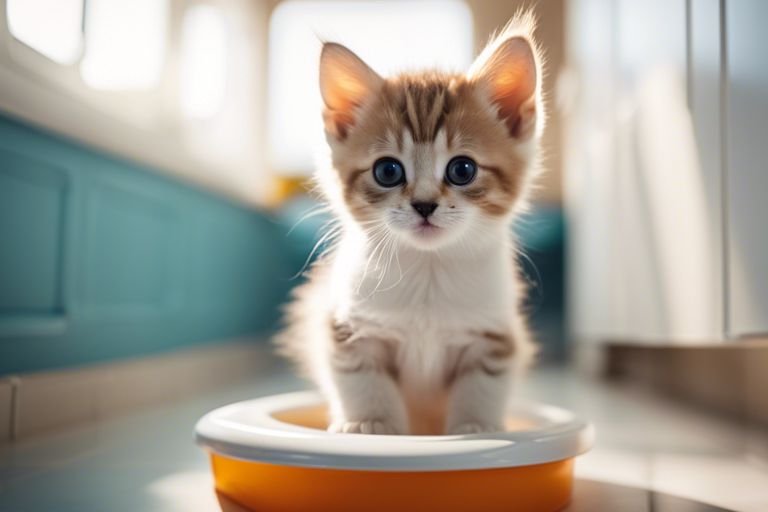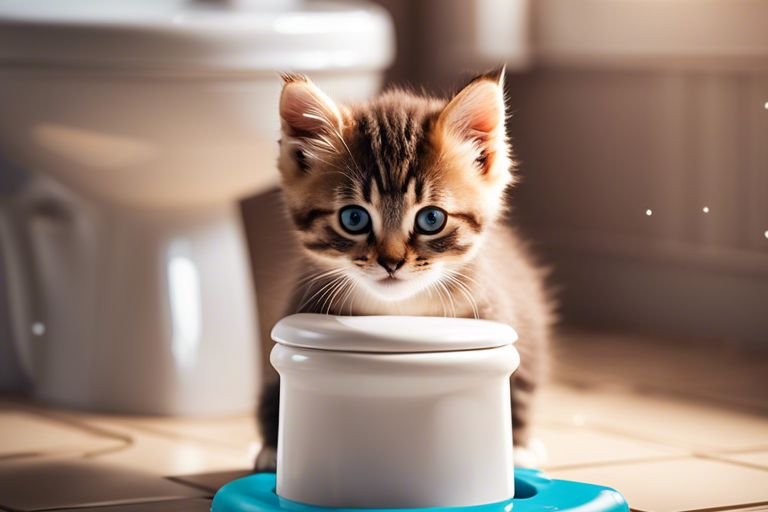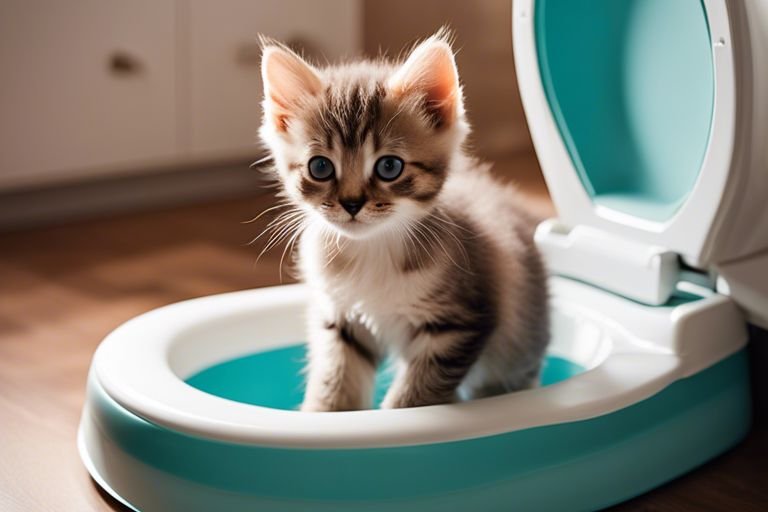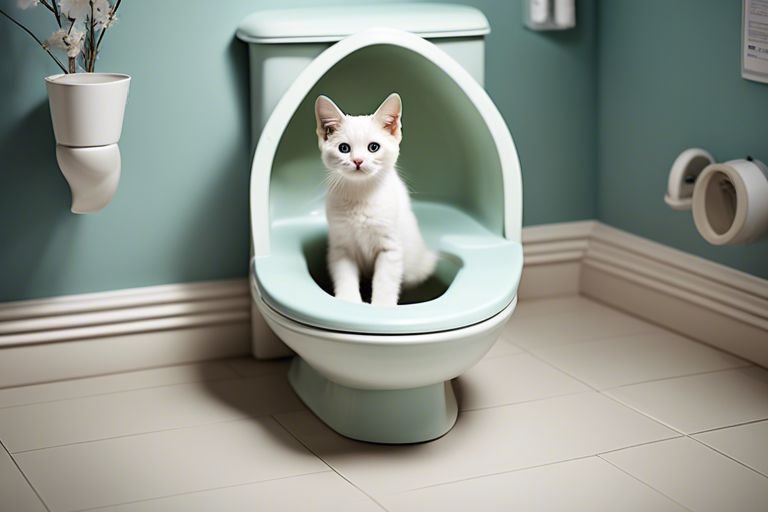Cat Potty Training – A Step-by-Step Guide For Beginners

There’s nothing quite like the joy of having a cat in your life, but dealing with a litter box can be a hassle. If you’re tired of the mess and the smell, it may be time to consider cat potty training your feline friend. In this step-by-step guide, we will walk you through the process of teaching your cat to use the toilet like a pro. Say goodbye to litter scooping and hello to a cleaner, more convenient way for your cat to do their business.
Key Takeaways:
- Start early: Introduce your cat to the litter box as early as possible to begin the potty training process.
- Consistency is key: Establish a routine for your cat’s potty breaks and stick to it to help them learn where to go.
- Use positive reinforcement: Reward your cat with treats or praise when they use the litter box correctly to encourage good behavior.
- Keep the litter box clean: Regularly clean the litter box to ensure your cat always has a clean and inviting place to do their business.
- Be patient and understanding: Cat Potty training takes time and each cat learns at their own pace, so be patient and provide support throughout the process.

Types of Cat Potty Training Methods
One of the imperative aspects of cat potty training is understanding the various methods available to train your feline friend. Each cat is unique, and what works for one may not work for another. It’s imperative to explore different options to find the best fit for your cat. Here are some common types of cat potty training methods:
| 1. Litter Box Training | 4. Clicker Training |
| 2. Toilet Training for Cats | 5. Crate Training |
| 3. Outdoor Training | 6. Paper Training |
Litter Box Training
An imperative method for most cat owners, litter box training involves introducing your cat to a designated box filled with cat litter for them to use instead of other areas in your home. Place the litter box in a quiet and accessible location for your cat, and regularly clean and maintain it to encourage consistent use.
Toilet Training for Cats
One innovative approach to cat potty training is teaching your cat to use the toilet. This method involves gradually transitioning your cat from the litter box to a specially designed cat toilet trainer that fits over the rim of the toilet seat. Training your cat to use the toilet can be a rewarding experience for both you and your feline companion.
Training your cat to use the toilet requires patience, consistency, and positive reinforcement. It’s imperative to take the time to properly introduce your cat to the toilet training process and provide encouragement and rewards for progress. Remember that not all cats will take to toilet training, so be prepared to switch to a different method if needed.
Factors to Consider Before Starting
- Age and adaptability of your cat
- Analyzing your cat’s behavior and preferences
Age and Adaptability of Your Cat
If you are considering potty training your cat, you should first assess the age and adaptability of your feline friend. Cats are creatures of habit, and younger cats tend to adapt more easily to new routines compared to older cats. If your cat is older or has a history of difficulty adjusting to change, you may need to approach the training process with more patience and understanding.
Analyzing Your Cat's Behavior and Preferences
While all cats share some common behaviors, each cat has its own unique personality and preferences. Before starting the cat potty training process, take the time to observe your cat’s behavior and habits. Does your cat have a preferred litter type? Is there a specific area where your cat likes to eliminate? By understanding your cat’s preferences, you can tailor the training process to suit your cat’s needs and increase the chances of success.
Consider consulting with your veterinarian if you have concerns about your cat’s ability to adapt to potty training. They can provide guidance and advice specific to your cat’s age, health status, and individual needs.

Step-by-Step Cat Potty Training
Many cat owners find the idea of potty training their feline companions daunting, but with the right approach and consistency, it can be a manageable process. Breaking down the training into specific steps can help both you and your cat navigate this new skill together.
| Preparing Your Home for Training | Tips for Successful Litter Box Training |
|---|---|
| Training your cat to use a litter box requires setting up a quiet, accessible location for the box, ensuring it is large enough, and using the right kind of litter. |
Knowing your cat’s preferences and habits can help you choose the best litter and box setup for successful training. |
The Transition from Litter Box to Toilet
Litter box to toilet training can be a game-changer for cat owners looking to eliminate the need for a litter box in their homes. This transition requires patience, consistency, and the right approach to ensure success.
Step-by-step, introduce your cat to the idea of using a toilet by gradually elevating the litter box until it reaches the same height as the toilet seat. Encourage your cat to use the box in its new position until they are comfortable. Knowing your cat’s comfort level and adjusting the training pace accordingly is key to a smooth transition.
Troubleshooting Common Potty Training Issues
Potty training can come with its challenges, from litter box aversion to accidents outside the designated area. Understanding common issues and how to address them can make the training process smoother for both you and your cat.
Litter box aversion can be caused by various factors, including an unclean box, wrong type of litter, or location preferences. By identifying the root cause of the aversion and making adjustments, you can help your cat get back on track with their potty training.

Pros and Cons of Cat Potty Training
Your journey into cat potty training can have various advantages and drawbacks. Let’s explore the pros and cons in the table below:
| Pros | Cons |
| Eliminates litter box | Requires patience and consistency |
| Reduces odor and mess | Potential for accidents on floors |
| Potentially saves on litter costs | Some cats may resist the training |
| Environmentally friendly | Not suitable for all cat breeds |
| Builds a bond through training | Requires commitment and supervision |
Looking for a structured cat potty training program? Check out Charles Mingus Cat Toilet Training Program for expert guidance.
Advantages of Teaching Your Cat to Use the Toilet
Toilet training your cat comes with several advantages. Not only does it eliminate the need for a litter box, but it also reduces odor and mess in your home. Additionally, teaching your cat to use the toilet can strengthen the bond between you and your furry friend.
Potential Drawbacks and How to Overcome Them
With any cat potty training method, there are potential drawbacks to consider. Some cats may resist the training process, leading to accidents on your floors. However, with patience, consistency, and positive reinforcement, you can overcome these challenges and successfully train your cat to use the toilet.
Summing up
Upon reflecting on the step-by-step guide to cat potty training for beginners, it is clear that with patience, consistency, and positive reinforcement, it is possible to successfully train your cat to use a litter box. By following the tips and techniques outlined in this guide, cat owners can navigate the challenges of potty training with confidence. Remember to always be patient and understanding with your cat throughout the training process, and celebrate their progress along the way. With dedication and effort, you and your feline companion can establish a clean and stress-free environment in your home.
FAQ
Q: What is cat potty training?
A: Cat potty training is the process of teaching a cat to use a litter box or go outside to eliminate waste. It involves guiding your cat to the designated area to do its business and reinforcing the desired behavior through positive reinforcement.
Q: At what age can I start potty training my cat?
A: You can start potty training your cat as early as 8 weeks old. Kittens are easier to train than older cats, but with patience and consistency, even adult cats can learn to use a litter box.
Q: How can I potty train my cat to use a litter box?
A: To potty train your cat to use a litter box, place the box in a quiet, accessible location, introduce your cat to the box, and praise and reward them when they use it. Keep the box clean and make sure it is big enough for your cat to comfortably move around in.
Q: What are some common mistakes to avoid when potty training a cat?
A: Some common mistakes to avoid when potty training a cat include punishing your cat for accidents, using a litter box with a hood (which some cats find intimidating), not scooping the box regularly, and not providing enough litter boxes for multiple cats in the household.
Q: How long does it take to potty train a cat?
A: The time it takes to potty train a cat varies depending on the cat’s age, previous experiences, and personality. Some cats may learn quickly within a few days, while others may take weeks or months to fully grasp the concept. Consistency and positive reinforcement are key to successful potty training.




